Analysis Report: Economic Principles and Decision Making in Australia
VerifiedAdded on 2022/10/14
|18
|4173
|392
Report
AI Summary
This report analyzes the economic performance of Australia, focusing on the slowdown experienced in the second half of 2018. It examines key factors contributing to this slowdown, including the housing market decline, the economic slowdown in China, falling household consumption, and declining wage growth. The report delves into the current state of the Australian economy, presenting statistical data and figures related to GDP and employment growth. It explores the influence of both global and domestic factors on Australia's economic landscape, with particular attention to the impact of the housing market in Sydney and Melbourne. The report also discusses the role of the Reserve Bank of Australia in setting monetary policy and adjusting the cash rate. Furthermore, the report provides an overview of the current economic situation, highlighting key factors such as consumption, investment, government expenditure, and net export. The report also provides a detailed analysis of the housing market, including median house prices and mortgage arrears. The report further investigates the economic slowdown of China and its impact on Australia, including trade relations, commodity prices, and financial markets. The report concludes with a discussion of growth expectations and the design of monetary policy.
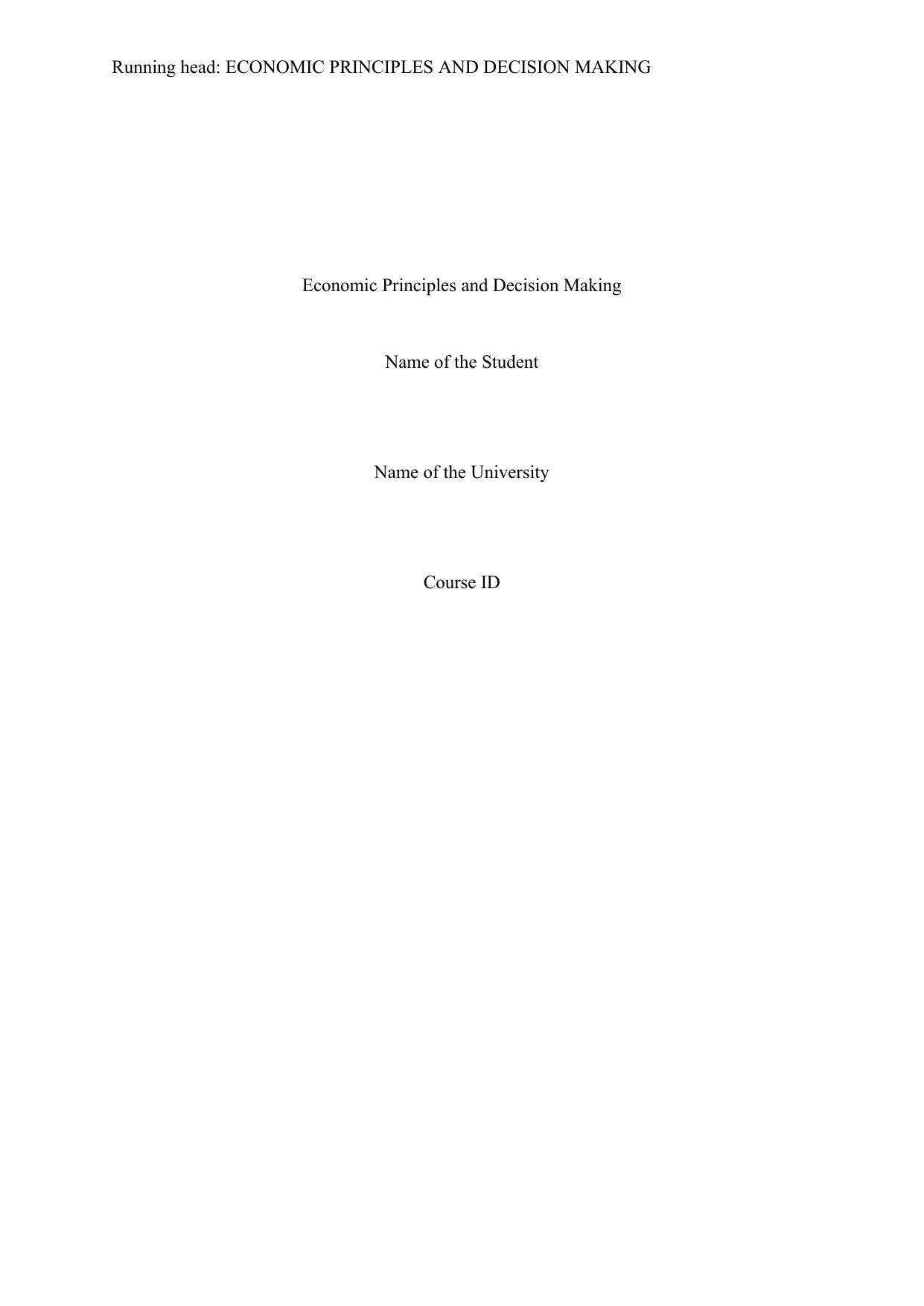
Running head: ECONOMIC PRINCIPLES AND DECISION MAKING
Economic Principles and Decision Making
Name of the Student
Name of the University
Course ID
Economic Principles and Decision Making
Name of the Student
Name of the University
Course ID
Paraphrase This Document
Need a fresh take? Get an instant paraphrase of this document with our AI Paraphraser

1ECONOMIC PRINCIPLES AND DECISION MAKING
Table of Contents
Introduction................................................................................................................................2
Current state of Australian economy..........................................................................................3
Factors explaining slow economic growth in Australia.............................................................5
Slowdown in housing market.................................................................................................5
Economic slowdown of China...............................................................................................7
Fall in household consumption..............................................................................................8
Decline in wage growth.........................................................................................................9
Growth expectation and design of monetary policy................................................................10
Conclusion................................................................................................................................12
References................................................................................................................................13
Table of Contents
Introduction................................................................................................................................2
Current state of Australian economy..........................................................................................3
Factors explaining slow economic growth in Australia.............................................................5
Slowdown in housing market.................................................................................................5
Economic slowdown of China...............................................................................................7
Fall in household consumption..............................................................................................8
Decline in wage growth.........................................................................................................9
Growth expectation and design of monetary policy................................................................10
Conclusion................................................................................................................................12
References................................................................................................................................13
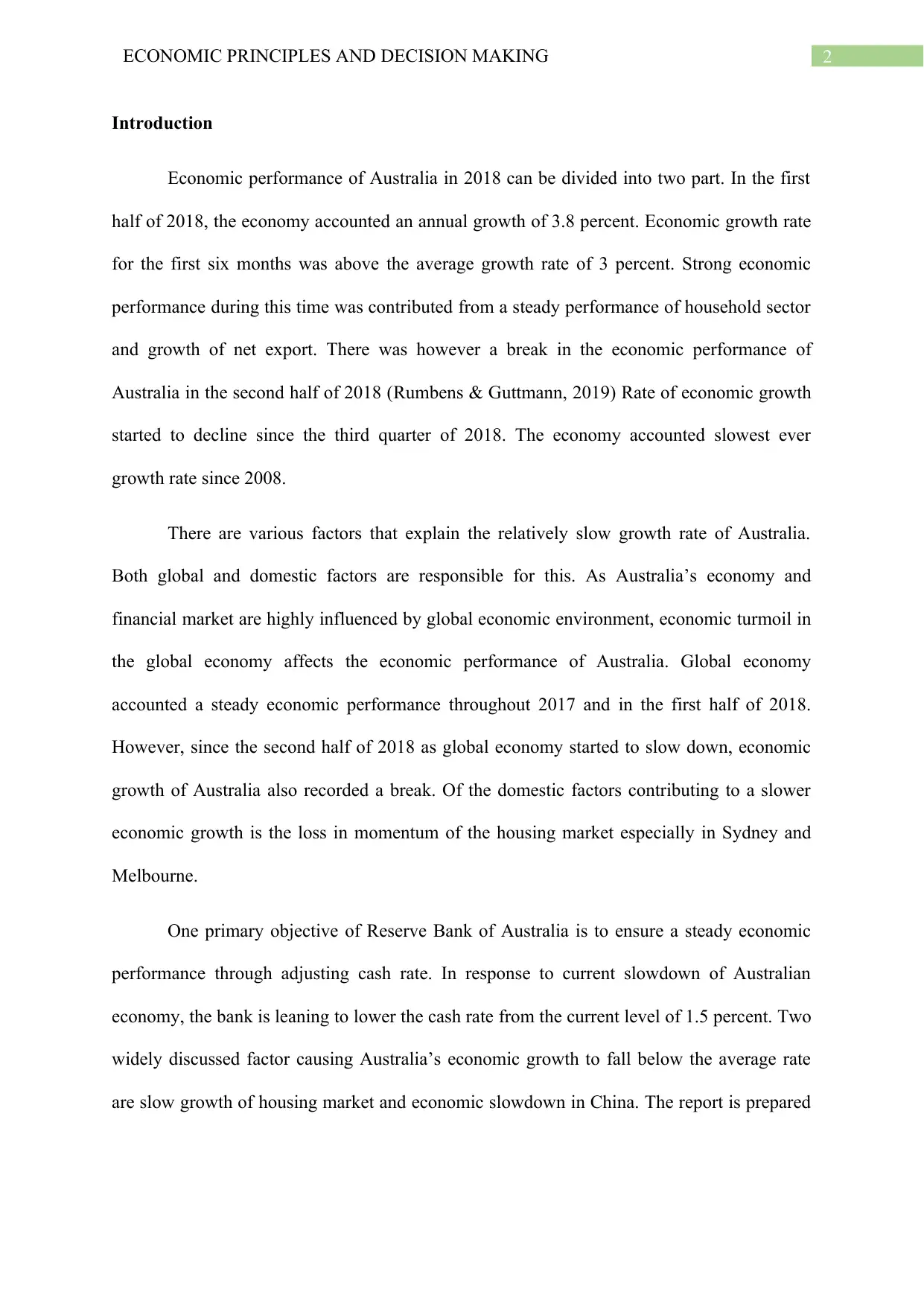
2ECONOMIC PRINCIPLES AND DECISION MAKING
Introduction
Economic performance of Australia in 2018 can be divided into two part. In the first
half of 2018, the economy accounted an annual growth of 3.8 percent. Economic growth rate
for the first six months was above the average growth rate of 3 percent. Strong economic
performance during this time was contributed from a steady performance of household sector
and growth of net export. There was however a break in the economic performance of
Australia in the second half of 2018 (Rumbens & Guttmann, 2019) Rate of economic growth
started to decline since the third quarter of 2018. The economy accounted slowest ever
growth rate since 2008.
There are various factors that explain the relatively slow growth rate of Australia.
Both global and domestic factors are responsible for this. As Australia’s economy and
financial market are highly influenced by global economic environment, economic turmoil in
the global economy affects the economic performance of Australia. Global economy
accounted a steady economic performance throughout 2017 and in the first half of 2018.
However, since the second half of 2018 as global economy started to slow down, economic
growth of Australia also recorded a break. Of the domestic factors contributing to a slower
economic growth is the loss in momentum of the housing market especially in Sydney and
Melbourne.
One primary objective of Reserve Bank of Australia is to ensure a steady economic
performance through adjusting cash rate. In response to current slowdown of Australian
economy, the bank is leaning to lower the cash rate from the current level of 1.5 percent. Two
widely discussed factor causing Australia’s economic growth to fall below the average rate
are slow growth of housing market and economic slowdown in China. The report is prepared
Introduction
Economic performance of Australia in 2018 can be divided into two part. In the first
half of 2018, the economy accounted an annual growth of 3.8 percent. Economic growth rate
for the first six months was above the average growth rate of 3 percent. Strong economic
performance during this time was contributed from a steady performance of household sector
and growth of net export. There was however a break in the economic performance of
Australia in the second half of 2018 (Rumbens & Guttmann, 2019) Rate of economic growth
started to decline since the third quarter of 2018. The economy accounted slowest ever
growth rate since 2008.
There are various factors that explain the relatively slow growth rate of Australia.
Both global and domestic factors are responsible for this. As Australia’s economy and
financial market are highly influenced by global economic environment, economic turmoil in
the global economy affects the economic performance of Australia. Global economy
accounted a steady economic performance throughout 2017 and in the first half of 2018.
However, since the second half of 2018 as global economy started to slow down, economic
growth of Australia also recorded a break. Of the domestic factors contributing to a slower
economic growth is the loss in momentum of the housing market especially in Sydney and
Melbourne.
One primary objective of Reserve Bank of Australia is to ensure a steady economic
performance through adjusting cash rate. In response to current slowdown of Australian
economy, the bank is leaning to lower the cash rate from the current level of 1.5 percent. Two
widely discussed factor causing Australia’s economic growth to fall below the average rate
are slow growth of housing market and economic slowdown in China. The report is prepared
⊘ This is a preview!⊘
Do you want full access?
Subscribe today to unlock all pages.

Trusted by 1+ million students worldwide
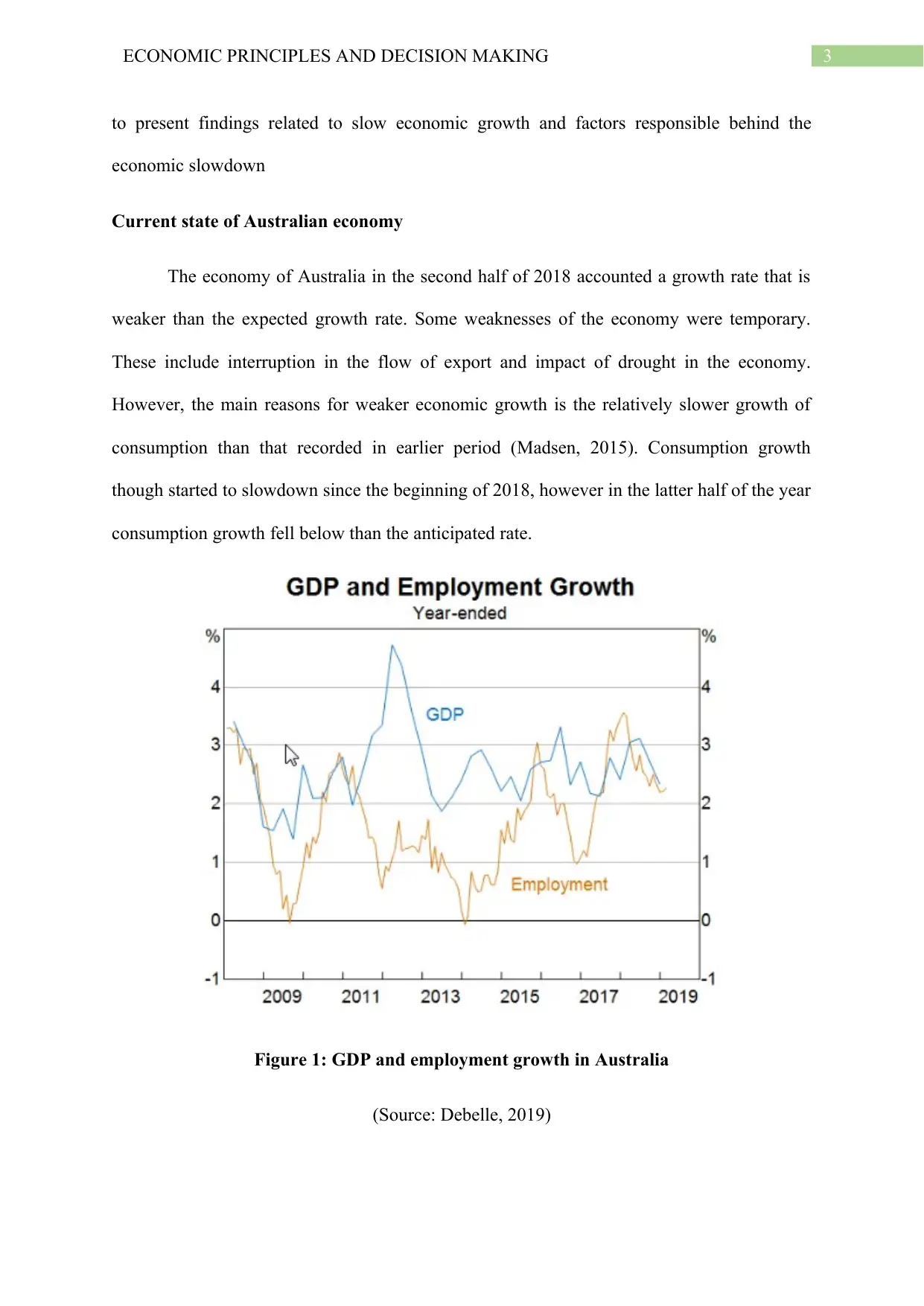
3ECONOMIC PRINCIPLES AND DECISION MAKING
to present findings related to slow economic growth and factors responsible behind the
economic slowdown
Current state of Australian economy
The economy of Australia in the second half of 2018 accounted a growth rate that is
weaker than the expected growth rate. Some weaknesses of the economy were temporary.
These include interruption in the flow of export and impact of drought in the economy.
However, the main reasons for weaker economic growth is the relatively slower growth of
consumption than that recorded in earlier period (Madsen, 2015). Consumption growth
though started to slowdown since the beginning of 2018, however in the latter half of the year
consumption growth fell below than the anticipated rate.
Figure 1: GDP and employment growth in Australia
(Source: Debelle, 2019)
to present findings related to slow economic growth and factors responsible behind the
economic slowdown
Current state of Australian economy
The economy of Australia in the second half of 2018 accounted a growth rate that is
weaker than the expected growth rate. Some weaknesses of the economy were temporary.
These include interruption in the flow of export and impact of drought in the economy.
However, the main reasons for weaker economic growth is the relatively slower growth of
consumption than that recorded in earlier period (Madsen, 2015). Consumption growth
though started to slowdown since the beginning of 2018, however in the latter half of the year
consumption growth fell below than the anticipated rate.
Figure 1: GDP and employment growth in Australia
(Source: Debelle, 2019)
Paraphrase This Document
Need a fresh take? Get an instant paraphrase of this document with our AI Paraphraser
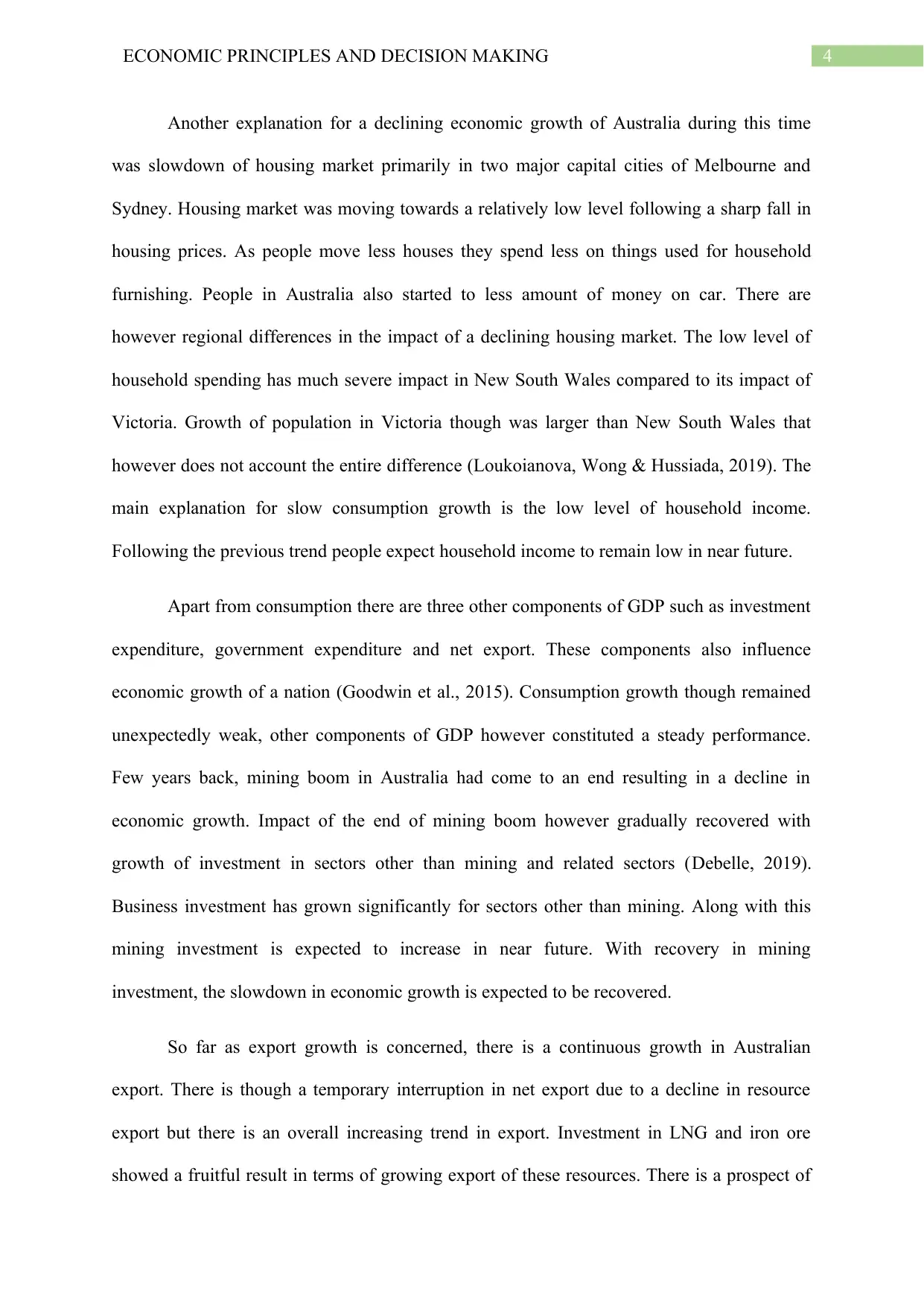
4ECONOMIC PRINCIPLES AND DECISION MAKING
Another explanation for a declining economic growth of Australia during this time
was slowdown of housing market primarily in two major capital cities of Melbourne and
Sydney. Housing market was moving towards a relatively low level following a sharp fall in
housing prices. As people move less houses they spend less on things used for household
furnishing. People in Australia also started to less amount of money on car. There are
however regional differences in the impact of a declining housing market. The low level of
household spending has much severe impact in New South Wales compared to its impact of
Victoria. Growth of population in Victoria though was larger than New South Wales that
however does not account the entire difference (Loukoianova, Wong & Hussiada, 2019). The
main explanation for slow consumption growth is the low level of household income.
Following the previous trend people expect household income to remain low in near future.
Apart from consumption there are three other components of GDP such as investment
expenditure, government expenditure and net export. These components also influence
economic growth of a nation (Goodwin et al., 2015). Consumption growth though remained
unexpectedly weak, other components of GDP however constituted a steady performance.
Few years back, mining boom in Australia had come to an end resulting in a decline in
economic growth. Impact of the end of mining boom however gradually recovered with
growth of investment in sectors other than mining and related sectors (Debelle, 2019).
Business investment has grown significantly for sectors other than mining. Along with this
mining investment is expected to increase in near future. With recovery in mining
investment, the slowdown in economic growth is expected to be recovered.
So far as export growth is concerned, there is a continuous growth in Australian
export. There is though a temporary interruption in net export due to a decline in resource
export but there is an overall increasing trend in export. Investment in LNG and iron ore
showed a fruitful result in terms of growing export of these resources. There is a prospect of
Another explanation for a declining economic growth of Australia during this time
was slowdown of housing market primarily in two major capital cities of Melbourne and
Sydney. Housing market was moving towards a relatively low level following a sharp fall in
housing prices. As people move less houses they spend less on things used for household
furnishing. People in Australia also started to less amount of money on car. There are
however regional differences in the impact of a declining housing market. The low level of
household spending has much severe impact in New South Wales compared to its impact of
Victoria. Growth of population in Victoria though was larger than New South Wales that
however does not account the entire difference (Loukoianova, Wong & Hussiada, 2019). The
main explanation for slow consumption growth is the low level of household income.
Following the previous trend people expect household income to remain low in near future.
Apart from consumption there are three other components of GDP such as investment
expenditure, government expenditure and net export. These components also influence
economic growth of a nation (Goodwin et al., 2015). Consumption growth though remained
unexpectedly weak, other components of GDP however constituted a steady performance.
Few years back, mining boom in Australia had come to an end resulting in a decline in
economic growth. Impact of the end of mining boom however gradually recovered with
growth of investment in sectors other than mining and related sectors (Debelle, 2019).
Business investment has grown significantly for sectors other than mining. Along with this
mining investment is expected to increase in near future. With recovery in mining
investment, the slowdown in economic growth is expected to be recovered.
So far as export growth is concerned, there is a continuous growth in Australian
export. There is though a temporary interruption in net export due to a decline in resource
export but there is an overall increasing trend in export. Investment in LNG and iron ore
showed a fruitful result in terms of growing export of these resources. There is a prospect of
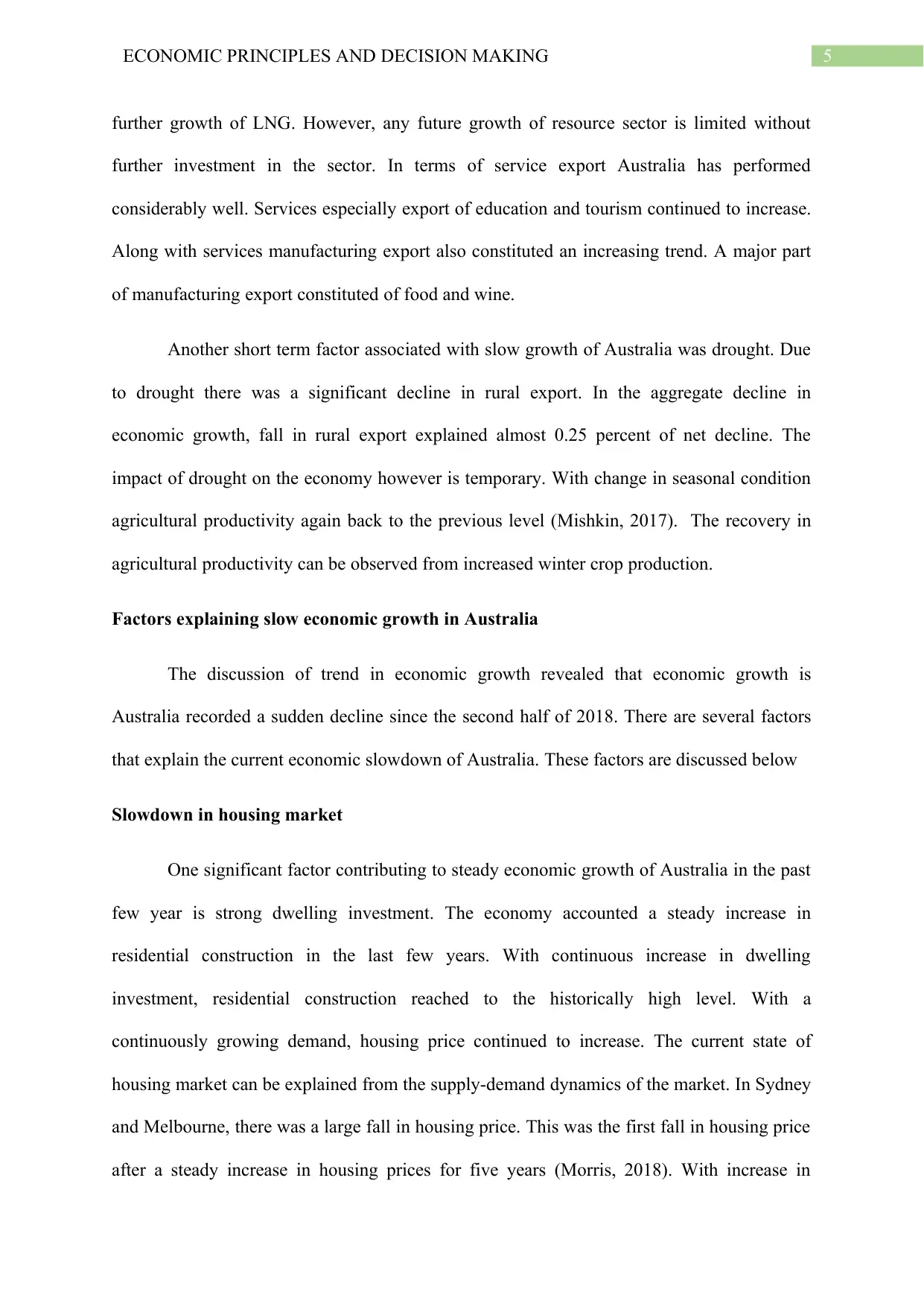
5ECONOMIC PRINCIPLES AND DECISION MAKING
further growth of LNG. However, any future growth of resource sector is limited without
further investment in the sector. In terms of service export Australia has performed
considerably well. Services especially export of education and tourism continued to increase.
Along with services manufacturing export also constituted an increasing trend. A major part
of manufacturing export constituted of food and wine.
Another short term factor associated with slow growth of Australia was drought. Due
to drought there was a significant decline in rural export. In the aggregate decline in
economic growth, fall in rural export explained almost 0.25 percent of net decline. The
impact of drought on the economy however is temporary. With change in seasonal condition
agricultural productivity again back to the previous level (Mishkin, 2017). The recovery in
agricultural productivity can be observed from increased winter crop production.
Factors explaining slow economic growth in Australia
The discussion of trend in economic growth revealed that economic growth is
Australia recorded a sudden decline since the second half of 2018. There are several factors
that explain the current economic slowdown of Australia. These factors are discussed below
Slowdown in housing market
One significant factor contributing to steady economic growth of Australia in the past
few year is strong dwelling investment. The economy accounted a steady increase in
residential construction in the last few years. With continuous increase in dwelling
investment, residential construction reached to the historically high level. With a
continuously growing demand, housing price continued to increase. The current state of
housing market can be explained from the supply-demand dynamics of the market. In Sydney
and Melbourne, there was a large fall in housing price. This was the first fall in housing price
after a steady increase in housing prices for five years (Morris, 2018). With increase in
further growth of LNG. However, any future growth of resource sector is limited without
further investment in the sector. In terms of service export Australia has performed
considerably well. Services especially export of education and tourism continued to increase.
Along with services manufacturing export also constituted an increasing trend. A major part
of manufacturing export constituted of food and wine.
Another short term factor associated with slow growth of Australia was drought. Due
to drought there was a significant decline in rural export. In the aggregate decline in
economic growth, fall in rural export explained almost 0.25 percent of net decline. The
impact of drought on the economy however is temporary. With change in seasonal condition
agricultural productivity again back to the previous level (Mishkin, 2017). The recovery in
agricultural productivity can be observed from increased winter crop production.
Factors explaining slow economic growth in Australia
The discussion of trend in economic growth revealed that economic growth is
Australia recorded a sudden decline since the second half of 2018. There are several factors
that explain the current economic slowdown of Australia. These factors are discussed below
Slowdown in housing market
One significant factor contributing to steady economic growth of Australia in the past
few year is strong dwelling investment. The economy accounted a steady increase in
residential construction in the last few years. With continuous increase in dwelling
investment, residential construction reached to the historically high level. With a
continuously growing demand, housing price continued to increase. The current state of
housing market can be explained from the supply-demand dynamics of the market. In Sydney
and Melbourne, there was a large fall in housing price. This was the first fall in housing price
after a steady increase in housing prices for five years (Morris, 2018). With increase in
⊘ This is a preview!⊘
Do you want full access?
Subscribe today to unlock all pages.

Trusted by 1+ million students worldwide
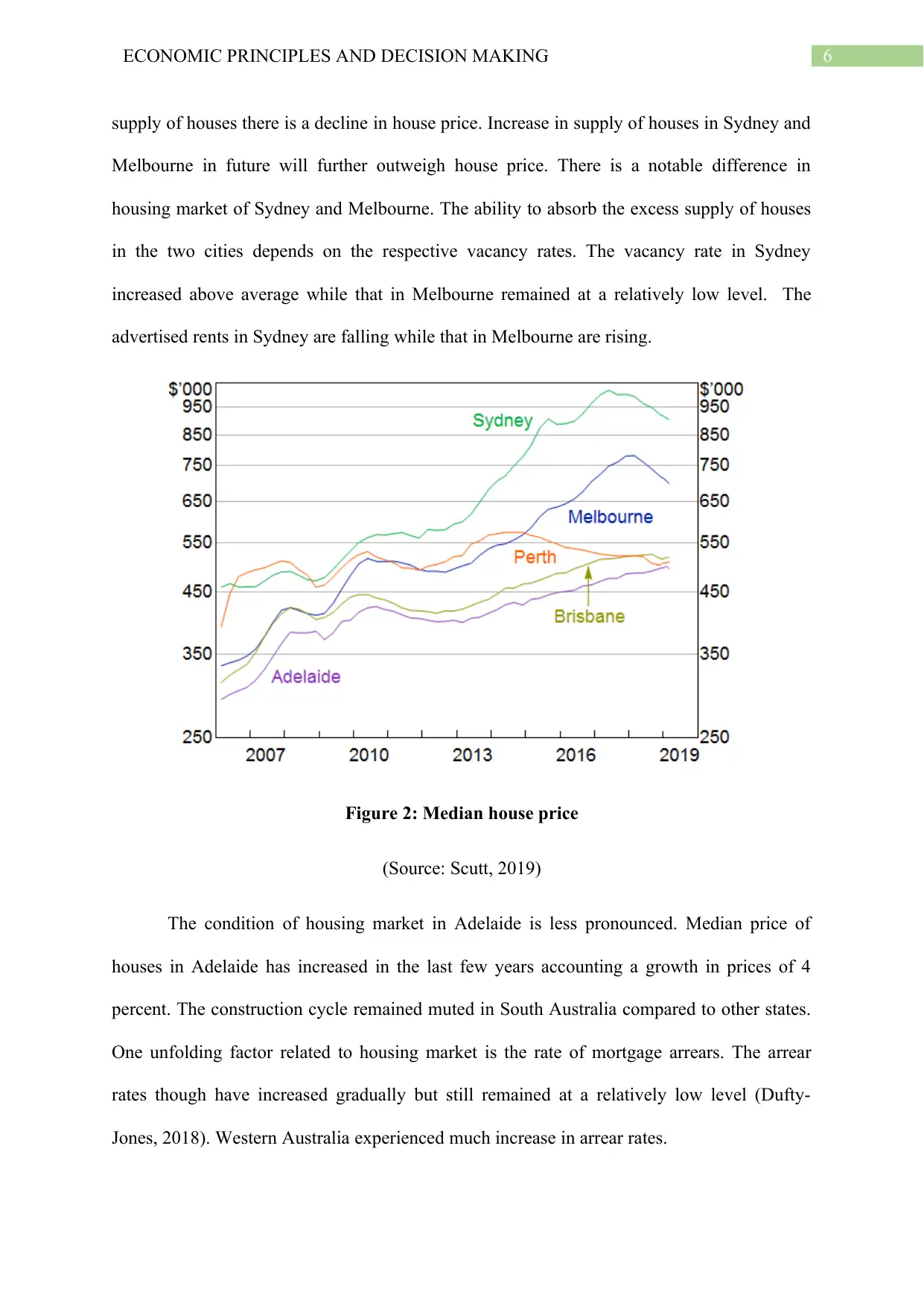
6ECONOMIC PRINCIPLES AND DECISION MAKING
supply of houses there is a decline in house price. Increase in supply of houses in Sydney and
Melbourne in future will further outweigh house price. There is a notable difference in
housing market of Sydney and Melbourne. The ability to absorb the excess supply of houses
in the two cities depends on the respective vacancy rates. The vacancy rate in Sydney
increased above average while that in Melbourne remained at a relatively low level. The
advertised rents in Sydney are falling while that in Melbourne are rising.
Figure 2: Median house price
(Source: Scutt, 2019)
The condition of housing market in Adelaide is less pronounced. Median price of
houses in Adelaide has increased in the last few years accounting a growth in prices of 4
percent. The construction cycle remained muted in South Australia compared to other states.
One unfolding factor related to housing market is the rate of mortgage arrears. The arrear
rates though have increased gradually but still remained at a relatively low level (Dufty-
Jones, 2018). Western Australia experienced much increase in arrear rates.
supply of houses there is a decline in house price. Increase in supply of houses in Sydney and
Melbourne in future will further outweigh house price. There is a notable difference in
housing market of Sydney and Melbourne. The ability to absorb the excess supply of houses
in the two cities depends on the respective vacancy rates. The vacancy rate in Sydney
increased above average while that in Melbourne remained at a relatively low level. The
advertised rents in Sydney are falling while that in Melbourne are rising.
Figure 2: Median house price
(Source: Scutt, 2019)
The condition of housing market in Adelaide is less pronounced. Median price of
houses in Adelaide has increased in the last few years accounting a growth in prices of 4
percent. The construction cycle remained muted in South Australia compared to other states.
One unfolding factor related to housing market is the rate of mortgage arrears. The arrear
rates though have increased gradually but still remained at a relatively low level (Dufty-
Jones, 2018). Western Australia experienced much increase in arrear rates.
Paraphrase This Document
Need a fresh take? Get an instant paraphrase of this document with our AI Paraphraser

7ECONOMIC PRINCIPLES AND DECISION MAKING
The decline in household prices now has reached to the officially lowest level.
Following a continuous downfall of 20 months, housing price declined by 0.4 percent in
May. The cumulative decline in housing price recorded to be 8.2 percent (Scutt, 2019). This
surpassed the previous downturn of housing price in the beginning of 1980s. The current
downturn of housing price so far is the longest. Price is further forecasted to decline by 10
percent. Construction sector being one of the most important sector of the economy, a decline
in dwelling investment has marked a significant downturn of the economy.
Economic slowdown of China
In the past few decades, the economy of China experienced an annual average growth
rate of 8 percent. The faster growth in China’s economy had brought by spread of
urbanization, industrialization and increasing openness of China to world trade. China’s
economic growth was mostly based on strong dependency on natural resources which in turn
developed a wider export market for resource rich nation like Australia. Australia export a
bulk amount of coking coal and iron ore to China. The growing trade relation between China
and Australia made China one of the largest trading partners of Australia accounting one third
of export and one fifth of import of Australia (Fabre, 2016). The strong interconnection
between the two nation indicates that risk from economic slowdown in China bring
uncertainty for Australia’s economy.
The pace of economic growth in China how changed along with a change in
composition of economic growth. During the period of post financial crisis, the economic
growth of China was fueled by increase in residential construction and infrastructural
investment along with large amount of debt which created a large demand for exported good
of Australia (Cashin, Mohaddes & Raissi, 2017). However, since 2011 economic growth of
China started to decline. The economic fell from a recorded 10 percent to 6.6 percent
The decline in household prices now has reached to the officially lowest level.
Following a continuous downfall of 20 months, housing price declined by 0.4 percent in
May. The cumulative decline in housing price recorded to be 8.2 percent (Scutt, 2019). This
surpassed the previous downturn of housing price in the beginning of 1980s. The current
downturn of housing price so far is the longest. Price is further forecasted to decline by 10
percent. Construction sector being one of the most important sector of the economy, a decline
in dwelling investment has marked a significant downturn of the economy.
Economic slowdown of China
In the past few decades, the economy of China experienced an annual average growth
rate of 8 percent. The faster growth in China’s economy had brought by spread of
urbanization, industrialization and increasing openness of China to world trade. China’s
economic growth was mostly based on strong dependency on natural resources which in turn
developed a wider export market for resource rich nation like Australia. Australia export a
bulk amount of coking coal and iron ore to China. The growing trade relation between China
and Australia made China one of the largest trading partners of Australia accounting one third
of export and one fifth of import of Australia (Fabre, 2016). The strong interconnection
between the two nation indicates that risk from economic slowdown in China bring
uncertainty for Australia’s economy.
The pace of economic growth in China how changed along with a change in
composition of economic growth. During the period of post financial crisis, the economic
growth of China was fueled by increase in residential construction and infrastructural
investment along with large amount of debt which created a large demand for exported good
of Australia (Cashin, Mohaddes & Raissi, 2017). However, since 2011 economic growth of
China started to decline. The economic fell from a recorded 10 percent to 6.6 percent
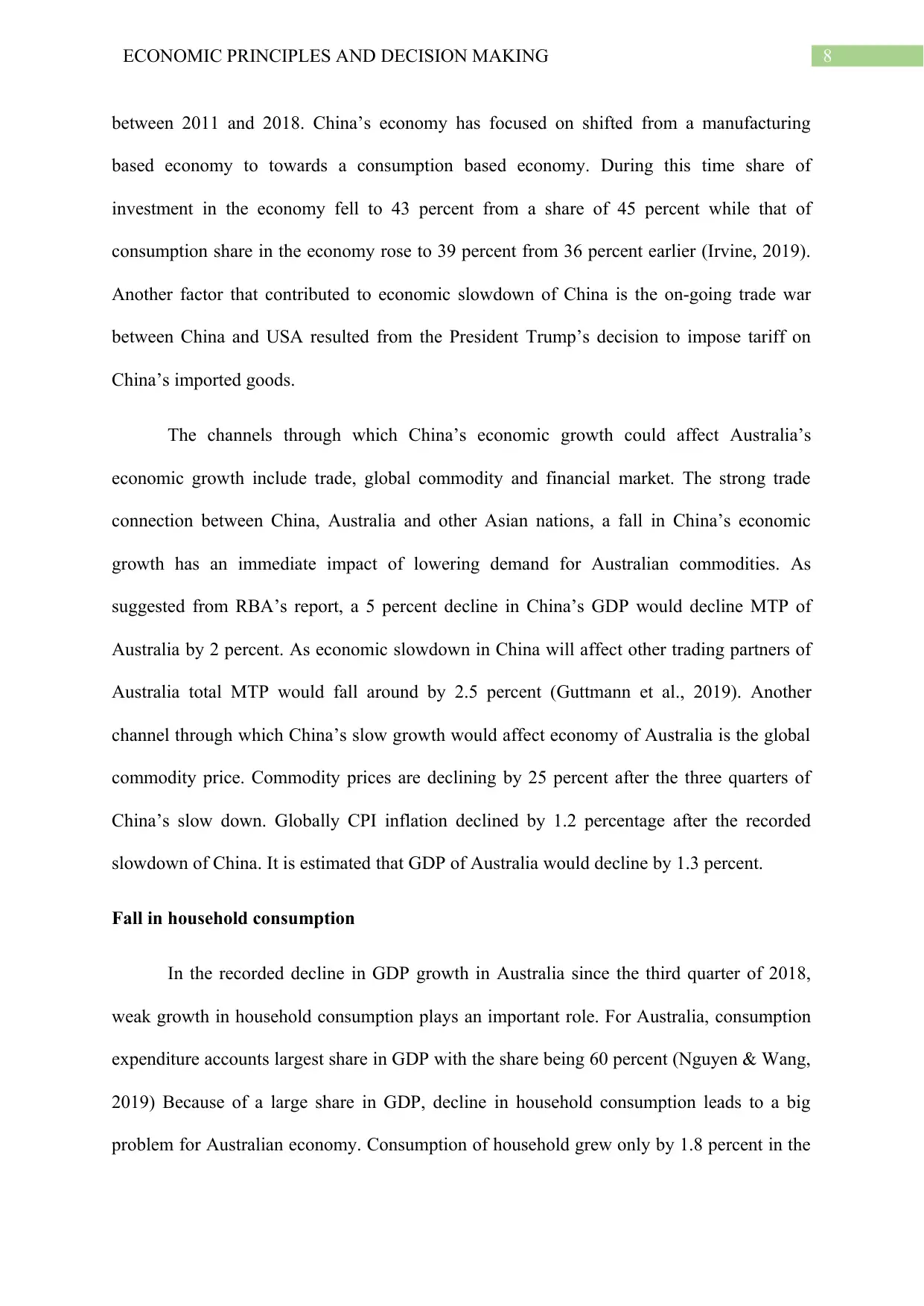
8ECONOMIC PRINCIPLES AND DECISION MAKING
between 2011 and 2018. China’s economy has focused on shifted from a manufacturing
based economy to towards a consumption based economy. During this time share of
investment in the economy fell to 43 percent from a share of 45 percent while that of
consumption share in the economy rose to 39 percent from 36 percent earlier (Irvine, 2019).
Another factor that contributed to economic slowdown of China is the on-going trade war
between China and USA resulted from the President Trump’s decision to impose tariff on
China’s imported goods.
The channels through which China’s economic growth could affect Australia’s
economic growth include trade, global commodity and financial market. The strong trade
connection between China, Australia and other Asian nations, a fall in China’s economic
growth has an immediate impact of lowering demand for Australian commodities. As
suggested from RBA’s report, a 5 percent decline in China’s GDP would decline MTP of
Australia by 2 percent. As economic slowdown in China will affect other trading partners of
Australia total MTP would fall around by 2.5 percent (Guttmann et al., 2019). Another
channel through which China’s slow growth would affect economy of Australia is the global
commodity price. Commodity prices are declining by 25 percent after the three quarters of
China’s slow down. Globally CPI inflation declined by 1.2 percentage after the recorded
slowdown of China. It is estimated that GDP of Australia would decline by 1.3 percent.
Fall in household consumption
In the recorded decline in GDP growth in Australia since the third quarter of 2018,
weak growth in household consumption plays an important role. For Australia, consumption
expenditure accounts largest share in GDP with the share being 60 percent (Nguyen & Wang,
2019) Because of a large share in GDP, decline in household consumption leads to a big
problem for Australian economy. Consumption of household grew only by 1.8 percent in the
between 2011 and 2018. China’s economy has focused on shifted from a manufacturing
based economy to towards a consumption based economy. During this time share of
investment in the economy fell to 43 percent from a share of 45 percent while that of
consumption share in the economy rose to 39 percent from 36 percent earlier (Irvine, 2019).
Another factor that contributed to economic slowdown of China is the on-going trade war
between China and USA resulted from the President Trump’s decision to impose tariff on
China’s imported goods.
The channels through which China’s economic growth could affect Australia’s
economic growth include trade, global commodity and financial market. The strong trade
connection between China, Australia and other Asian nations, a fall in China’s economic
growth has an immediate impact of lowering demand for Australian commodities. As
suggested from RBA’s report, a 5 percent decline in China’s GDP would decline MTP of
Australia by 2 percent. As economic slowdown in China will affect other trading partners of
Australia total MTP would fall around by 2.5 percent (Guttmann et al., 2019). Another
channel through which China’s slow growth would affect economy of Australia is the global
commodity price. Commodity prices are declining by 25 percent after the three quarters of
China’s slow down. Globally CPI inflation declined by 1.2 percentage after the recorded
slowdown of China. It is estimated that GDP of Australia would decline by 1.3 percent.
Fall in household consumption
In the recorded decline in GDP growth in Australia since the third quarter of 2018,
weak growth in household consumption plays an important role. For Australia, consumption
expenditure accounts largest share in GDP with the share being 60 percent (Nguyen & Wang,
2019) Because of a large share in GDP, decline in household consumption leads to a big
problem for Australian economy. Consumption of household grew only by 1.8 percent in the
⊘ This is a preview!⊘
Do you want full access?
Subscribe today to unlock all pages.

Trusted by 1+ million students worldwide
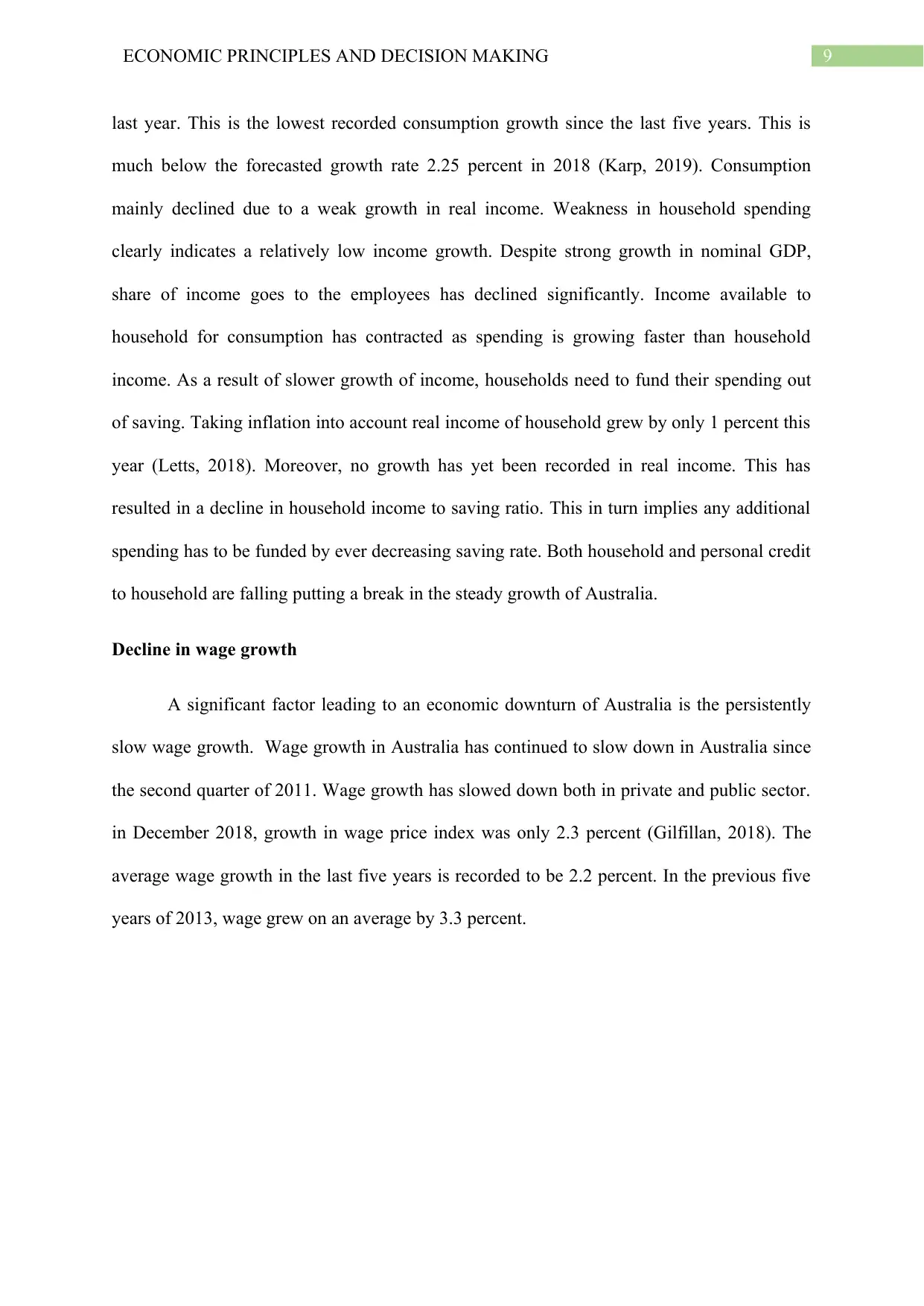
9ECONOMIC PRINCIPLES AND DECISION MAKING
last year. This is the lowest recorded consumption growth since the last five years. This is
much below the forecasted growth rate 2.25 percent in 2018 (Karp, 2019). Consumption
mainly declined due to a weak growth in real income. Weakness in household spending
clearly indicates a relatively low income growth. Despite strong growth in nominal GDP,
share of income goes to the employees has declined significantly. Income available to
household for consumption has contracted as spending is growing faster than household
income. As a result of slower growth of income, households need to fund their spending out
of saving. Taking inflation into account real income of household grew by only 1 percent this
year (Letts, 2018). Moreover, no growth has yet been recorded in real income. This has
resulted in a decline in household income to saving ratio. This in turn implies any additional
spending has to be funded by ever decreasing saving rate. Both household and personal credit
to household are falling putting a break in the steady growth of Australia.
Decline in wage growth
A significant factor leading to an economic downturn of Australia is the persistently
slow wage growth. Wage growth in Australia has continued to slow down in Australia since
the second quarter of 2011. Wage growth has slowed down both in private and public sector.
in December 2018, growth in wage price index was only 2.3 percent (Gilfillan, 2018). The
average wage growth in the last five years is recorded to be 2.2 percent. In the previous five
years of 2013, wage grew on an average by 3.3 percent.
last year. This is the lowest recorded consumption growth since the last five years. This is
much below the forecasted growth rate 2.25 percent in 2018 (Karp, 2019). Consumption
mainly declined due to a weak growth in real income. Weakness in household spending
clearly indicates a relatively low income growth. Despite strong growth in nominal GDP,
share of income goes to the employees has declined significantly. Income available to
household for consumption has contracted as spending is growing faster than household
income. As a result of slower growth of income, households need to fund their spending out
of saving. Taking inflation into account real income of household grew by only 1 percent this
year (Letts, 2018). Moreover, no growth has yet been recorded in real income. This has
resulted in a decline in household income to saving ratio. This in turn implies any additional
spending has to be funded by ever decreasing saving rate. Both household and personal credit
to household are falling putting a break in the steady growth of Australia.
Decline in wage growth
A significant factor leading to an economic downturn of Australia is the persistently
slow wage growth. Wage growth in Australia has continued to slow down in Australia since
the second quarter of 2011. Wage growth has slowed down both in private and public sector.
in December 2018, growth in wage price index was only 2.3 percent (Gilfillan, 2018). The
average wage growth in the last five years is recorded to be 2.2 percent. In the previous five
years of 2013, wage grew on an average by 3.3 percent.
Paraphrase This Document
Need a fresh take? Get an instant paraphrase of this document with our AI Paraphraser
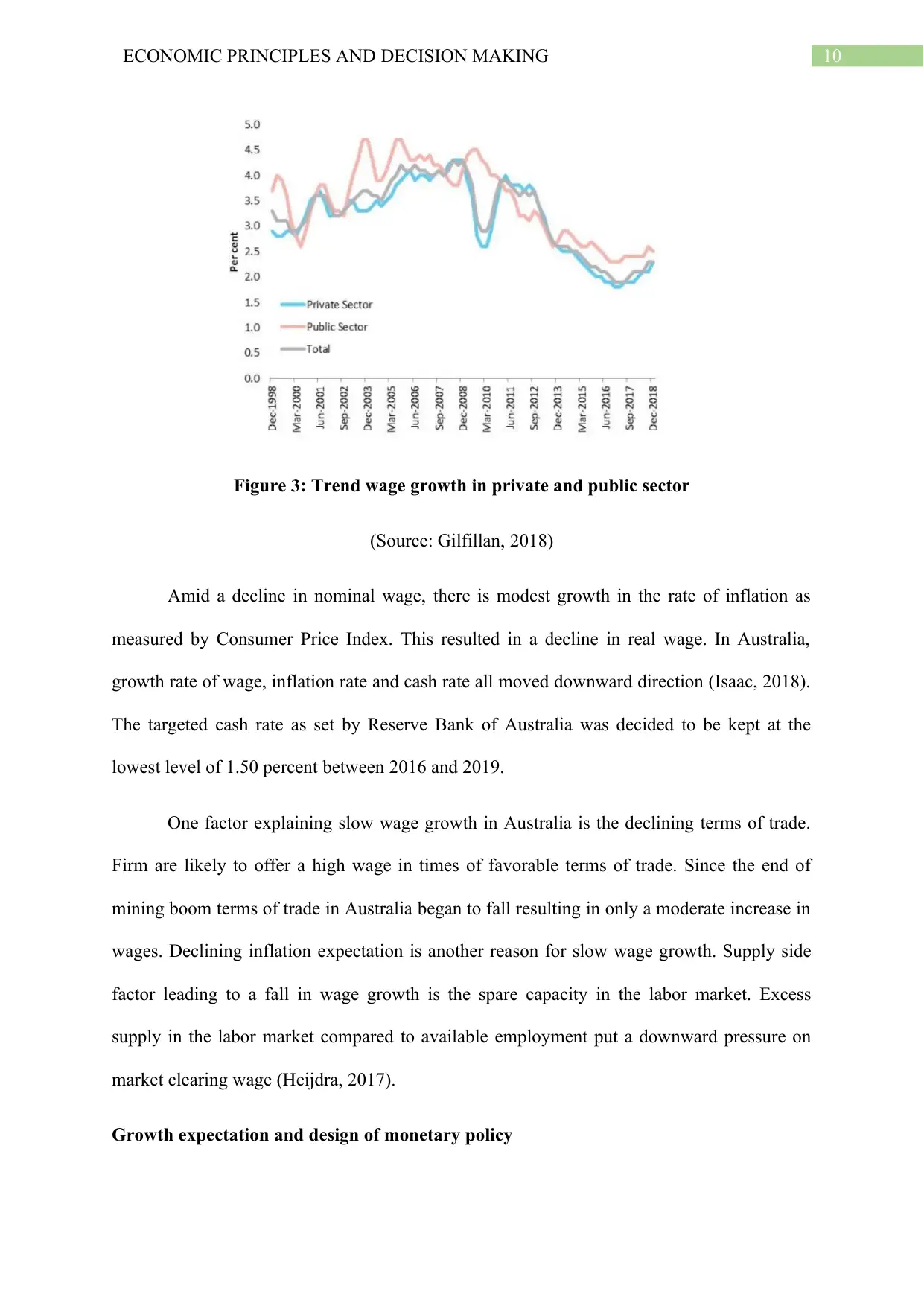
10ECONOMIC PRINCIPLES AND DECISION MAKING
Figure 3: Trend wage growth in private and public sector
(Source: Gilfillan, 2018)
Amid a decline in nominal wage, there is modest growth in the rate of inflation as
measured by Consumer Price Index. This resulted in a decline in real wage. In Australia,
growth rate of wage, inflation rate and cash rate all moved downward direction (Isaac, 2018).
The targeted cash rate as set by Reserve Bank of Australia was decided to be kept at the
lowest level of 1.50 percent between 2016 and 2019.
One factor explaining slow wage growth in Australia is the declining terms of trade.
Firm are likely to offer a high wage in times of favorable terms of trade. Since the end of
mining boom terms of trade in Australia began to fall resulting in only a moderate increase in
wages. Declining inflation expectation is another reason for slow wage growth. Supply side
factor leading to a fall in wage growth is the spare capacity in the labor market. Excess
supply in the labor market compared to available employment put a downward pressure on
market clearing wage (Heijdra, 2017).
Growth expectation and design of monetary policy
Figure 3: Trend wage growth in private and public sector
(Source: Gilfillan, 2018)
Amid a decline in nominal wage, there is modest growth in the rate of inflation as
measured by Consumer Price Index. This resulted in a decline in real wage. In Australia,
growth rate of wage, inflation rate and cash rate all moved downward direction (Isaac, 2018).
The targeted cash rate as set by Reserve Bank of Australia was decided to be kept at the
lowest level of 1.50 percent between 2016 and 2019.
One factor explaining slow wage growth in Australia is the declining terms of trade.
Firm are likely to offer a high wage in times of favorable terms of trade. Since the end of
mining boom terms of trade in Australia began to fall resulting in only a moderate increase in
wages. Declining inflation expectation is another reason for slow wage growth. Supply side
factor leading to a fall in wage growth is the spare capacity in the labor market. Excess
supply in the labor market compared to available employment put a downward pressure on
market clearing wage (Heijdra, 2017).
Growth expectation and design of monetary policy
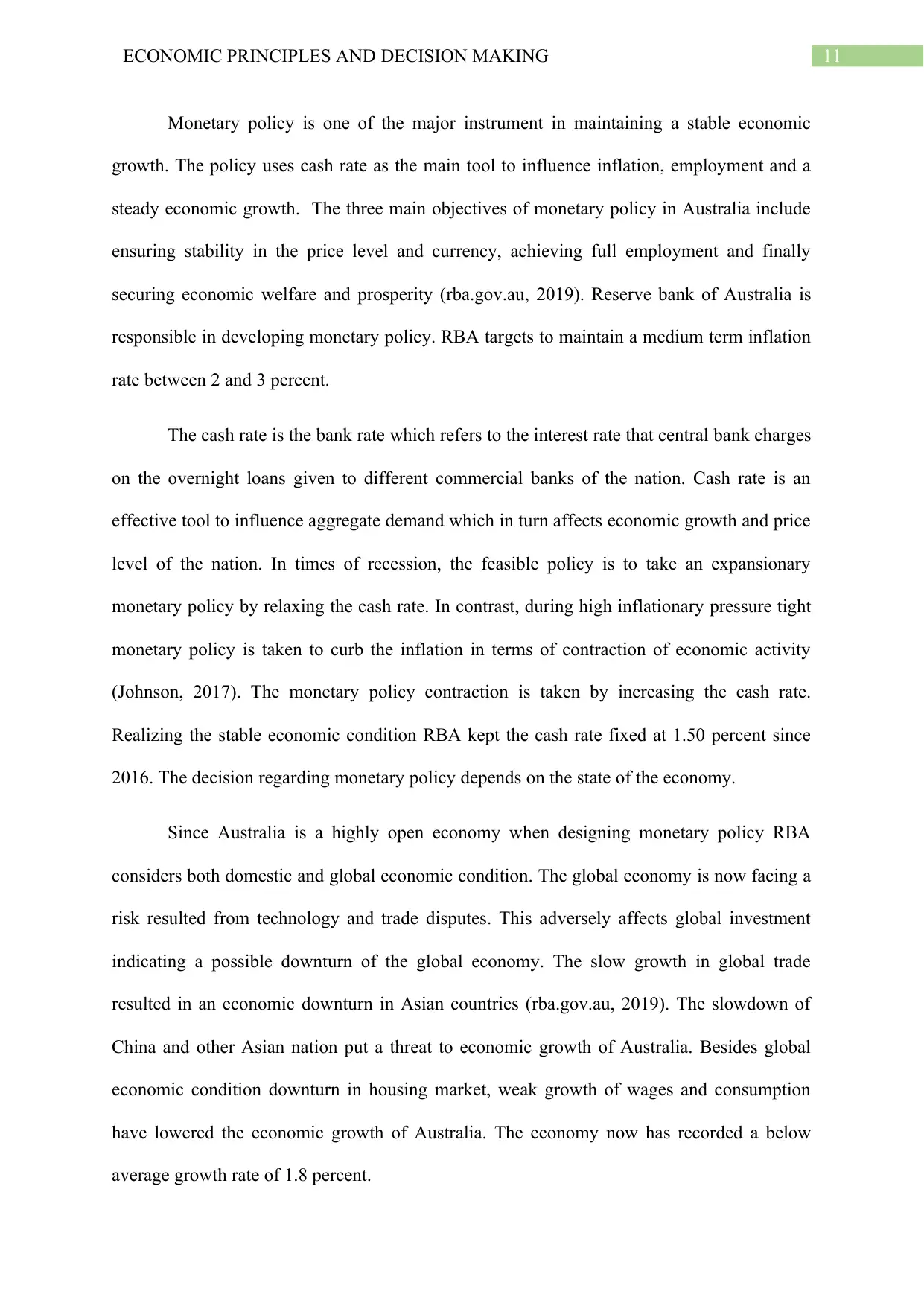
11ECONOMIC PRINCIPLES AND DECISION MAKING
Monetary policy is one of the major instrument in maintaining a stable economic
growth. The policy uses cash rate as the main tool to influence inflation, employment and a
steady economic growth. The three main objectives of monetary policy in Australia include
ensuring stability in the price level and currency, achieving full employment and finally
securing economic welfare and prosperity (rba.gov.au, 2019). Reserve bank of Australia is
responsible in developing monetary policy. RBA targets to maintain a medium term inflation
rate between 2 and 3 percent.
The cash rate is the bank rate which refers to the interest rate that central bank charges
on the overnight loans given to different commercial banks of the nation. Cash rate is an
effective tool to influence aggregate demand which in turn affects economic growth and price
level of the nation. In times of recession, the feasible policy is to take an expansionary
monetary policy by relaxing the cash rate. In contrast, during high inflationary pressure tight
monetary policy is taken to curb the inflation in terms of contraction of economic activity
(Johnson, 2017). The monetary policy contraction is taken by increasing the cash rate.
Realizing the stable economic condition RBA kept the cash rate fixed at 1.50 percent since
2016. The decision regarding monetary policy depends on the state of the economy.
Since Australia is a highly open economy when designing monetary policy RBA
considers both domestic and global economic condition. The global economy is now facing a
risk resulted from technology and trade disputes. This adversely affects global investment
indicating a possible downturn of the global economy. The slow growth in global trade
resulted in an economic downturn in Asian countries (rba.gov.au, 2019). The slowdown of
China and other Asian nation put a threat to economic growth of Australia. Besides global
economic condition downturn in housing market, weak growth of wages and consumption
have lowered the economic growth of Australia. The economy now has recorded a below
average growth rate of 1.8 percent.
Monetary policy is one of the major instrument in maintaining a stable economic
growth. The policy uses cash rate as the main tool to influence inflation, employment and a
steady economic growth. The three main objectives of monetary policy in Australia include
ensuring stability in the price level and currency, achieving full employment and finally
securing economic welfare and prosperity (rba.gov.au, 2019). Reserve bank of Australia is
responsible in developing monetary policy. RBA targets to maintain a medium term inflation
rate between 2 and 3 percent.
The cash rate is the bank rate which refers to the interest rate that central bank charges
on the overnight loans given to different commercial banks of the nation. Cash rate is an
effective tool to influence aggregate demand which in turn affects economic growth and price
level of the nation. In times of recession, the feasible policy is to take an expansionary
monetary policy by relaxing the cash rate. In contrast, during high inflationary pressure tight
monetary policy is taken to curb the inflation in terms of contraction of economic activity
(Johnson, 2017). The monetary policy contraction is taken by increasing the cash rate.
Realizing the stable economic condition RBA kept the cash rate fixed at 1.50 percent since
2016. The decision regarding monetary policy depends on the state of the economy.
Since Australia is a highly open economy when designing monetary policy RBA
considers both domestic and global economic condition. The global economy is now facing a
risk resulted from technology and trade disputes. This adversely affects global investment
indicating a possible downturn of the global economy. The slow growth in global trade
resulted in an economic downturn in Asian countries (rba.gov.au, 2019). The slowdown of
China and other Asian nation put a threat to economic growth of Australia. Besides global
economic condition downturn in housing market, weak growth of wages and consumption
have lowered the economic growth of Australia. The economy now has recorded a below
average growth rate of 1.8 percent.
⊘ This is a preview!⊘
Do you want full access?
Subscribe today to unlock all pages.

Trusted by 1+ million students worldwide
1 out of 18
Related Documents
Your All-in-One AI-Powered Toolkit for Academic Success.
+13062052269
info@desklib.com
Available 24*7 on WhatsApp / Email
![[object Object]](/_next/static/media/star-bottom.7253800d.svg)
Unlock your academic potential
Copyright © 2020–2025 A2Z Services. All Rights Reserved. Developed and managed by ZUCOL.





